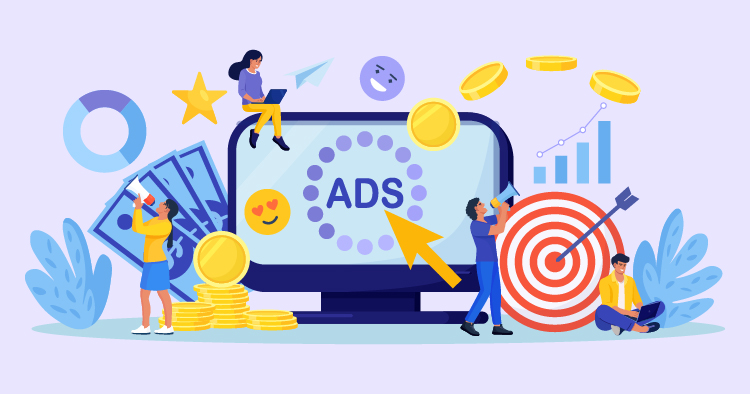Pay-per-click (PPC) advertising is a crucial strategy for businesses aiming to attract more online traffic and increase sales. It’s not just about setting up ads and hoping for the best; it’s about intelligent management. Choosing the right keywords, writing ads that speak to your audience, and deciding how much to spend are all critical decisions. With careful planning and ongoing adjustments, you can make the most of your budget and see a strong return on your investment. Let’s look at how you can boost your PPC campaigns to drive better results and profits.
Understanding PPC Advertising
Pay-per-click (PPC) advertising is an online marketing model in which businesses pay a fee each time their ads are clicked. Essentially, it’s a way of buying visits to your site rather than attempting to earn those visits organically. PPC is particularly valuable because it allows advertisers to bid on ad placement in a search engine’s sponsored links when someone searches for a keyword related to their business offering.
The beauty of PPC advertising is that it can reach potential customers who are considering buying something. It’s like having a digital billboard that pops up when someone is looking for your product or service. To manage a PPC campaign, you must handle various tasks, including choosing the right keywords, setting up campaigns and ad groups, writing ad copy, and creating landing pages that convert visitors into customers.
Benefits of PPC Advertising for Small Businesses
Small businesses can gain a lot from PPC advertising. It’s a powerful tool to connect with people actively searching for what you’re selling. The traffic from PPC ads is often more likely to buy, which can help increase your sales.
One of the most appealing aspects of PPC for small businesses is the speed at which it can work. You don’t have to wait long to see results, as you might with search engine optimization (SEO). Once your PPC campaign is active, you can immediately start seeing traffic—and potentially sales.
PPC also levels the playing field when competing with larger companies. Small businesses can bid on the exact keywords as extensive companies, and if they manage their campaigns well, they can achieve high visibility without necessarily having a large budget. This means that a small business with a limited budget can still make a significant impact, attracting new customers and growing its business.
Setting Clear Goals and Objectives
Having clear goals and objectives is essential when managing PPC advertising. Think of these goals as the destination on your road trip – you need to know where you’re going to plan your route. Goals can vary from increasing the number of visitors to your website to enhancing the rate at which these visitors take a desired action, such as making a purchase or signing up for a newsletter.
To be valid, these goals need to be specific and measurable. For example, rather than just aiming to increase sales, set a target for the exact number of sales or percentage increase you seek. This lets you track your progress and know when you’ve hit your mark.
Struggling with Digital marketing? Book Your Free Strategy Session!
- 30-Minutes Session
- Expert Insights
- Data-Driven approach
- Optimized Strategies for Your Goals
Conducting Keyword Research
Keyword research is like treasure hunting—you’re looking for phrases your potential customers use to find products or services like yours. The right keywords attract traffic and are used by people who are ready to take action.
You can use tools designed for this very purpose to find these valuable keywords. Google’s Keyword Planner is a good starting point; it can give you an idea of how often certain words are searched and how competitive they are. For more in-depth analysis, tools like SEMrush and Ahrefs can provide additional insights, such as keyword difficulty and potential search traffic.
Creating Compelling Ad Copy
The words in your ads are like a handshake—they make the first impression. Your ad copy should be engaging and relevant, catching the eye and connecting with the reader immediately. It should also clearly explain what makes your offering unique and why someone should be interested.
When writing your ad copy, focus on what makes your product or service better or different. This could be anything from superior quality to a discount or an exclusive feature. Remember to tell your potential customers what you want them to do next with a clear call to action, like ‘Buy now,’ ‘Sign up today,’ or ‘Learn more.’ This guide will significantly increase their chances of clicking on your ad.
Optimizing Landing Pages
Landing pages are essential for converting pay-per-click (PPC) traffic into customers. To make your landing pages work harder for you, they should be directly related to the ads that bring visitors there. If someone clicks on an ad for running shoes, the landing page should feature those shoes prominently, with information and a straightforward way to purchase them.
Make sure visitors can find what they need without a hassle. A confusing page can drive potential customers away. A strong, clear call to action, like “Buy Now” or “Sign Up Today,” tells visitors exactly what to do next. By creating a seamless and relevant experience from ad to landing page, you can increase your chances of turning clicks into sales, which is the ultimate goal of your PPC efforts.
Structuring Effective PPC Campaigns
Creating a successful PPC campaign is like building a house; you need a solid structure. Organizing your campaigns into specific ad groups can make a big difference if you’re running a small business. This helps you send a more precise message to different groups of people. For instance, if you sell sports equipment, you might have separate ad groups for “basketball shoes” and “running gear.”
Knowing who to target is just as important. You can show your ads to people in a specific location, age group, or even those interested in your offer. This way, you’re not spending money on ads that probably won’t interest anyone.
Lastly, think about how you spend your budget. It’s wise to put more money into the campaigns and ad groups that bring in the best results. By keeping an eye on what’s working and what’s not, you can adjust your spending to focus on the most profitable parts of your campaigns. This strategic approach to budgeting can help you get the most out of every dollar you spend on PPC advertising.
Struggling with Digital marketing? Book Your Free Strategy Session!
- 30-Minutes Session
- Expert Insights
- Data-Driven approach
- Optimized Strategies for Your Goals
Implementing Ad Extensions
Ad extensions are like a bonus for your pay-per-click (PPC) ads—they make your ads more extensive and informative, which can easily catch a potential customer’s eye. Think of them as extra bits of information that can tag along with your main ad, giving users more reasons to choose your business. For example, an ad extension could show your emergency service number in the search results if someone searches for a plumber. Or, if you have a sale, site link extensions can take customers straight to the sale page.
There’s a variety of ad extensions to choose from. Call extensions add a phone number to your ad, making it easy for customers to reach out. Location extensions show your business address, which is great for attracting local foot traffic. Site link extensions add links to specific pages on your website, like contact forms or product pages. These little extras can make a big difference—they can boost your ad’s visibility and click-through rate (CTR), which is the percentage of people who click on your ad after seeing it.
When you add these extensions, your ad takes up more space on the search results page, stands out more, and gives users more options to interact with your business. This can lead to a better ad rank, where your ad shows up on the search page, and can even help you get more clicks without spending more money. Ultimately, it’s all about getting more people to take the action you want, like buying a product or signing up for a newsletter.
Tracking and Analyzing Performance
Keeping an eye on your PPC ads’ performance is super important. It’s like having a fitness tracker for your ads—you get to see what’s working well and what’s not. By tracking your ads’ performance, you can determine whether you’re getting a good return on your investment (ROI) or throwing money into a black hole.
There are a bunch of tools out there to help with this. Conversion tracking tools tell you what happens after someone clicks on your ad—like whether they bought something or signed up for your mailing list. Google Analytics is another powerful tool that lets you see how people interact with your website after clicking on your ad. Then, there are key performance indicators (KPIs), like the vital signs for your ads. They include CTR, cost per conversion (how much you’re paying for each action a customer takes), and ROI (the return you’re getting from your ad spend).
By closely monitoring and analyzing these metrics, you can make intelligent decisions about your ads. For example, you may find that specific keywords bring in lots of sales, so you decide to invest more money in those ads. Or perhaps you’ll see that some ads aren’t doing so well, so you pause them and try a different approach. It’s all about tweaking and testing to ensure your PPC campaigns are as successful as possible.
A/B Testing and Optimization
A/B testing is a powerful tool in PPC (pay-per-click) advertising. It’s like conducting a science experiment to compare two versions of something to see which works better. For example, if you have an ad or a landing page, you create two different versions. Version A might have one headline, and version B a different one. Then, you show these versions to similar audiences to determine which leads to more clicks or sales.
The insights you gain from A/B tests can be precious. They help you understand what resonates with your audience. If you learn that one headline gets more clicks than another, you can use that style in your future ads. Or maybe you find that a particular color on your landing page leads to more sales. By making these informed changes, you’re fine-tuning your ads and landing pages to perform better. This is optimization, and it’s a continuous process that helps businesses get more out of their PPC campaigns and increase their return on investment (ROI).
Budgeting and Bidding Strategies
Deciding how much money to spend on PPC campaigns is like setting a budget for a shopping trip—you need to know what you can afford, what you’re shopping for, and what you hope to get out of it. Businesses must consider their overall marketing budget, the tough competition, and the returns they expect from their PPC efforts.
Struggling with Digital marketing? Book Your Free Strategy Session!
- 30-Minutes Session
- Expert Insights
- Data-Driven approach
- Optimized Strategies for Your Goals
There are several strategies to choose from when bidding for ad placements. The cost-per-click (CPC) strategy means you pay each time someone clicks on your ad. Cost-per-acquisition (CPA) bidding is where you pay only when someone takes a specific action, like purchasing or signing up for a newsletter. Then, automated bidding strategies adjust your bids using algorithms to get the best results based on your goals.
Choosing the right bidding strategy is crucial and depends on your goals. If you want to get as many people as possible to visit your site, CPC might be the way to go. If you’re focused on sales or sign-ups, CPA could be better. Automated bidding can save time and help optimize bids, but it requires trust in the algorithms and sometimes more budget flexibility. Each strategy has its place, and finding the right one is critical to maximizing your PPC campaigns.
Targeting the Right Audience
When you’re running pay-per-click (PPC) ads, it’s like throwing a party and sending out invitations. You want to ensure those invites go to the right people—those who will most likely enjoy the party and bring the best energy. That’s precisely what audience targeting does for your ads. It’s about finding the people most likely to be interested in what you’re selling, whether because of their age, where they live, what they’re interested in, or how they behave online.
When you get your message in front of these folks, they’re likelier to click on your ad, visit your site, and buy something. Plus, when you speak their language, they feel like you get them, which can make them more excited about what you’re offering. It’s a win-win: your ads perform better, and your audience feels understood.
Remarketing and Retargeting
Have you ever visited a website and then seen ads for that website everywhere you go online? That’s remarketing and retargeting at work. It’s like meeting someone interesting at a party and bumping into them again later. Those repeated encounters can help you remember them, and it’s the same with ads.
These strategies are super bright because they remind people about products or services they’ve already shown interest in. Maybe they visited your site but got distracted before buying anything. When they see your ad again, it’s like a little nudge saying, “Hey, remember us? We’ve got just what you need.” It’s a powerful way to bring people back to your site and encourage them to complete a purchase, especially if they need more time to think about it or if what you’re selling is a bit pricier.
Keeping your brand in their minds increases the chances they’ll return to you when they’re ready to buy. It’s a clever way to connect with potential customers and turn those almost-sales into real ones, helping your business grow.
Ad Quality Score and Ad Rank
Understanding ad quality scores is crucial when managing pay-per-click (PPC) advertising campaigns. Think of it as a report card for your ads, with grades based on their relevance and usefulness to users. This score is calculated from several components, including your ad’s click-through rate (CTR), how closely your keywords match the user’s intent, and the experience users have on your landing page.
Why does this matter? Well, a higher quality score can lead to a better ad rank. Ad rank determines where your ad appears in search results, and a higher rank means more visibility. This can translate into more clicks and potentially more sales or leads.
To improve your ad quality score and, therefore, your ad rank, focus on the following:
– Select keywords that closely match what your potential customers are searching for.
– Write ad copy that’s engaging and encourages users to click.
– Ensure your landing pages are informative, easy to navigate, and provide a good user experience.
You can improve your quality score by continuously refining these elements and testing different approaches. This helps your ads perform better and can lead to a more efficient use of your advertising budget.
Competitor Analysis
Competitor analysis is a powerful tool in PPC advertising. By watching what your competitors are doing, you can gain insights that help you make smarter campaign decisions. This process includes determining your main competitors, studying their advertising strategies, and using this knowledge to improve your PPC efforts.
Knowing where you stand compared to your competitors can give you a competitive edge. It can reveal what they’re doing well and where gaps in their strategies might exist that you can capitalize on.
Here’s how you can stay on top of competitor analysis:
– Keep tabs on their ad copy to see how they position their products or services.
– Monitor the keywords they’re targeting to find opportunities for your campaigns.
– Review their landing pages to understand how they’re converting visitors into customers.
Remember, competitor analysis isn’t a one-time task. It’s an ongoing part of managing your PPC campaigns that helps you adapt and refine your strategies over time. By staying informed about your competitors’ moves, you can make adjustments that keep your ads competitive and improve your return on investment.
Final Thoughts
After exploring PPC advertising management, it’s evident that success requires careful attention and ongoing effort. It’s all about analyzing the data, tweaking your campaigns, and keeping up with new platform trends and changes. Spending money on ads is just the beginning; the real investment is crafting a strategy that delivers precise, quantifiable results. Focus on making your ads relevant, reaching the right people, and refining your approach over time. With these practices, your PPC campaigns can be a dynamic driver of growth and success for your business.
PPC management is a dynamic process. It’s a cycle of measuring, adjusting, and improving. By committing to this process, you can ensure that your PPC efforts are not just a line item in your budget but a cornerstone of your marketing strategy that actively contributes to your business’s growth.



